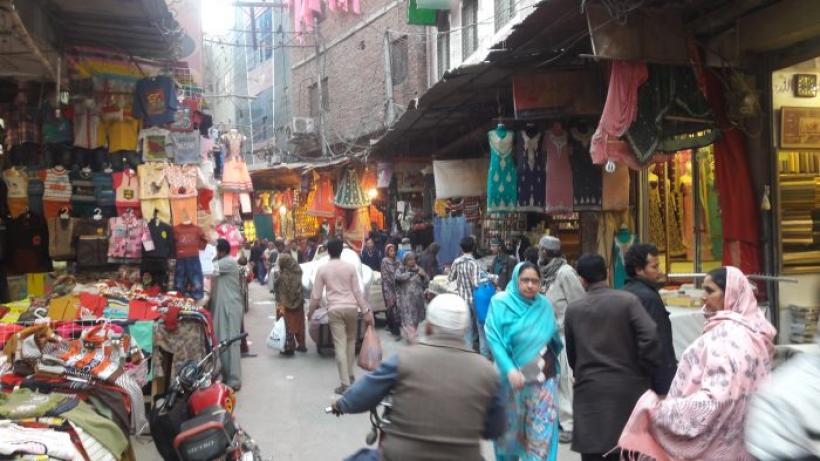
Protecting the unprotected: How can social protection reduce the vulnerability of informal workers?
Many countries like Pakistan need innovative solutions to mitigate the risks faced by its labour force, especially those engaged in informal work. A comprehensive social protection system that targets this vulnerable segment - not qualified as extremely poor nor employed in the formal sector - of the workforce can be one way to approach this.
Most informal workers don’t have access to social assistance programmes which are non-contributory transfers in cash, vouchers, or in-kind, directed at the extreme poor. They are also unable to avail contributory social insurance schemes that provide compensatory support and are enjoyed by formal workers employed in the public or private sector. This creates large gaps in social protection coverage for informal workers.
Pakistan may end up with as many as 181 million people needing jobs by 2050[i]. Not only will these people require employment, but also access to a safety net that protects their livelihood and ensures resilience in the face of adversities like natural calamities, economic downturns, and internal conflicts.
In several developing countries like Pakistan, Bangladesh, India, Indonesia and Nigeria, that collectively account for a third of the world’s population, the percentage of workers covered by social protection hovers around single digits[ii]. Majority of informal workers remain outside the realm of public policy.
Even though there is evidence that social protection can lead to significant welfare gains for workers, low state capacity poses substantial challenges to extending social protection to target workers[iii].
Social protection spending in Pakistan
Against a global average of 11.2%, Pakistan spends just under 2% of its GDP on social protection[iv]. Pakistan also has the lowest affiliation to pension schemes in the world. Active contributors to a pension scheme as a share of the labour force were last recorded at 5.4% in 2017, much lower than the South Asian average of 13.7%[v].
Total beneficiaries of all social protection schemes, as recorded in 2015, stands at 41 million (a quarter of the population)[vi]. Coverage rates for key target groups - unemployed, underemployed, the poor, persons with disabilities, children and elderly – is only 19.2% with almost 80% of the beneficiaries being non-poor[vii].
Almost 80% of the social protection expenditure is dominated by spending on social insurance[viii]. This primarily includes civilian and military pension payouts. Less than 1% is spent on contributory social insurance schemes that may be accessible to informal workers.
Expenditure on social assistance programmes is fueled by the Benazir Income Support Program (BISP), one of South Asia’s largest cash transfer programmes, that now reaches over 5.8 million families and targets the ultra-poor.
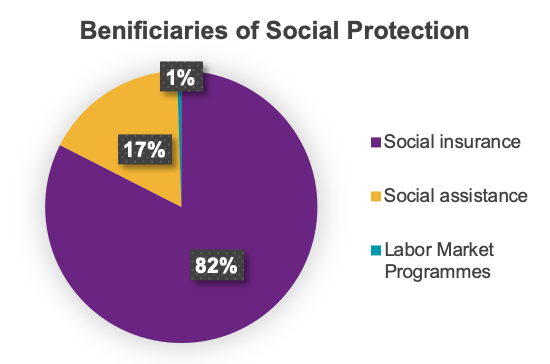
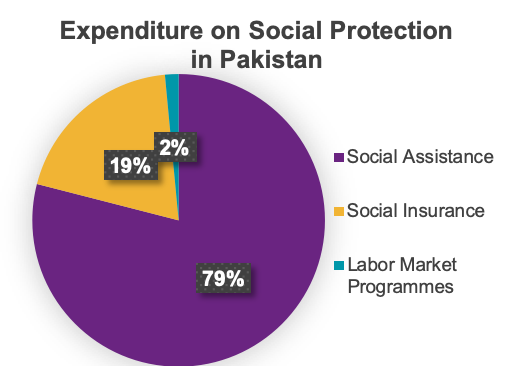
Source: ADB SPI 2015
What does informality look like in Pakistan?
Think of food stands lined across busy markets, vendors selling balloons and toys, the rickshaw drivers, street-side cobblers, home-based stitchers, embroiders, domestic workers, and now Uber drivers. They are all part of a global informal workforce that has now crossed the two billion mark[ix].
With a total population surpassing 200 million, the country has the ninth-largest workforce in the world[x]. More than 70% of the jobs outside agriculture are in the informal sector[xi], and of this, three quarters are taken up by women. Overall, Pakistan’s informal sector contributes one-third to its GDP[xii].
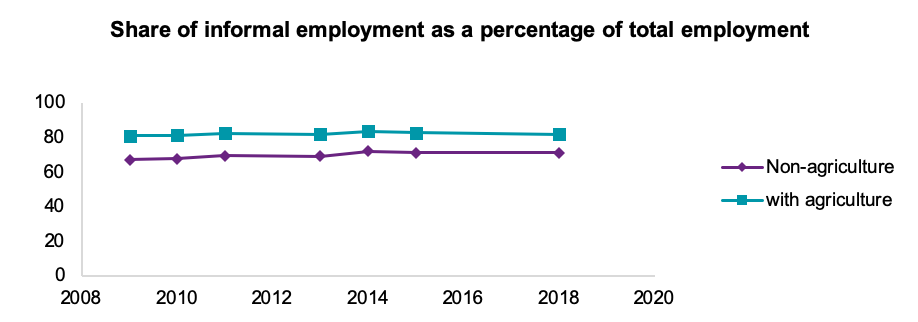
Source: ILO stats
Informal work remains concentrated among low-skilled, young, female, and rural workers and is dominated by household enterprises not formally registered, often with less than ten employees, street vendors, and domestic workers. Most labour laws (such as those determining minimum wage, terms of employment, and occupational safety) and social insurance regulations are not applicable to small and unregulated businesses.
Informal work also includes off-the-books hiring of home-based workers by registered firms and circumvents legislation. Of an estimated 12 million home-based workers, 80% are women.
A large share are own-account workers and more susceptible to seasonal fluctuations in income. With the advent of platforms such as Uber, the number of self-employed informal workers is expected to rise with the downside being that these companies would not be obliged to provide protection and benefits to the employees – considered 'self-employed' or independent contractors – using their platform.
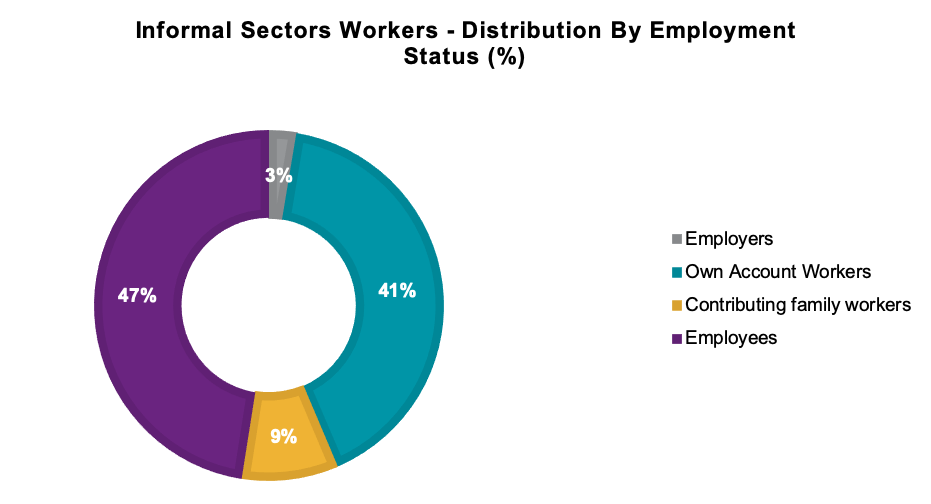
Source: LFS 2017-18
Moreover, informal workers are more prone to poverty than their formal sector counterparts. A large proportion have low educational attainment[xiii] and few receive any formal skills training. Several work without any employment contract and many are hired as daily wagers or temporary staff. Informal employees often work longer hours, yet many earn below or just around minimum wage. Many belong to households without alternate sources of income.
The enabling environment
Many gaps exist in the institutional and regulatory frameworks. Historically, labour policies have been divorced from legislation for informal workers. Own account, agriculture, home-based and domestic workers are not recognised as workers, nor their places of work as workplaces. Efforts are also underway to secure the rights of domestic and home-based workers[xiv]. However, provincial governments are yet to implement these policies.
Weak inspection systems also enable businesses to get away with noncompliance to labour laws including the lack of implementation of the stipulated minimum wage.
Pakistan’s labour laws also remain silent on the absence of unions and collective bargaining units in the informal sector. Only 2.3% of the country’s workforce (both formal and informal) are unionised.
What can the government do?
Firstly, social protection programmes need to move away from schemes designed specifically for formal, full-time and life-long (mainly male) workers, and towards accommodating more dynamic work patterns that have evolved with the informalisation of work. For a more complex landscape, innovative policies and regulatory frameworks are needed. Informal workers need to be integrated into mainstream social protection programmes that go beyond short-term targeted interventions.
Secondly, access to social insurance schemes must expand beyond those that can contribute. However, self-employed informal workers do not have an employer that can co-contribute to social insurance schemes. Informal workers may have to pay a proportionally higher share of their income compared to formal employees to join such schemes. Payments linked to social protection provisions can be matched to both the status of the enterprise concerned and the ability of the worker to pay. In addition, coverage can improve by allowing informal workers to self-register.
Thirdly, governments can use social protection as a tool to address vulnerabilities of informal workers and encourage their entry into the formal sector. Cash transfers under BISP can supplement low wages while a universal health insurance can provide maternity cover to women workers. Labour market interventions, such as skills development programmes, can also target the informal sector.
Lastly, a key challenge for any state would be to design sustainable financing mechanisms, including addressing the fiscal space. Some options to expand fiscal space are increasing tax revenue, boosting social insurance contributions, and reallocating public expenditures and restructuring debt.
How can researchers help?
Limited coverage of conventional models makes new approaches easier to embrace. This is an area where research can inform policy on several fronts.
Researchers can help governments by experimenting with ways to address constraints to expanding social protection to the informal sector. Extensive evaluations of existing social protection mechanisms such as cash transfer, universal health coverage and labour market programmes, can help understand their effectiveness and potential to extend coverage.
An important aspect of extending social protection to the informal sector is creating the necessary fiscal space and replacing existing informal mechanisms. Research can also help inform how new technology such as digital platforms and mobile services can improve the delivery of social protection to different categories of workers who may occasionally be unemployed.
Using existing data, investing in administrative data and socio-economic registries, and developing dynamic ways of capturing information beyond the extent of poverty to include knowledge about skills, capacities and interest, will help track socio-economic and demographic transitions to inform policy.
Research can help identify priority areas (such as access to health care, support for childcare needs etc) for the extension of social protection to informal workers.
Notes
[i] Population council estimates- By 2050 the country may end up with as many as 181 million people needing jobs: https://pakistan.unfpa.org/en/topics/demographic-dividend-5
[ii] https://www.imf.org/external/pubs/ft/fandd/2018/12/images/122018/rutkowski1-lg.jpg
[iii] For example, there is Evidence from an IGC funded research in Brazil shows how social insurance can be used to mitigate welfare losses for workers following a layoff
[iv] https://www.unescap.org/publications/social-outlook-asia-and-pacific-2018
[v] https://www.social-protection.org/gimi/OldAge.action
[vi] https://www.adb.org/publications/social-protection-indicator-asia
[vii] https://www.adb.org/publications/social-protection-indicator-asia
[viii] https://www.adb.org/publications/social-protection-indicator-asia
[ix] https://www.ilo.org/global/about-the-ilo/newsroom/news/WCMS_627189/lang--en/index.htm
[x] https://www.cia.gov/library/publications/the-world-factbook/rankorder/2095rank.html
[xi] Labor force survey 2018
[xii] Global Economic Prospects World Bank 2019.
[xiii] An Asian Development Bank report assessed provision of social protection to informal workers by undertaking survey of over 200 informal workers across three sectors. construction, garment manufacturing, and street vending.
[xiv] Recently Punjab and Sindh passed a bill to recognise home-based workers

